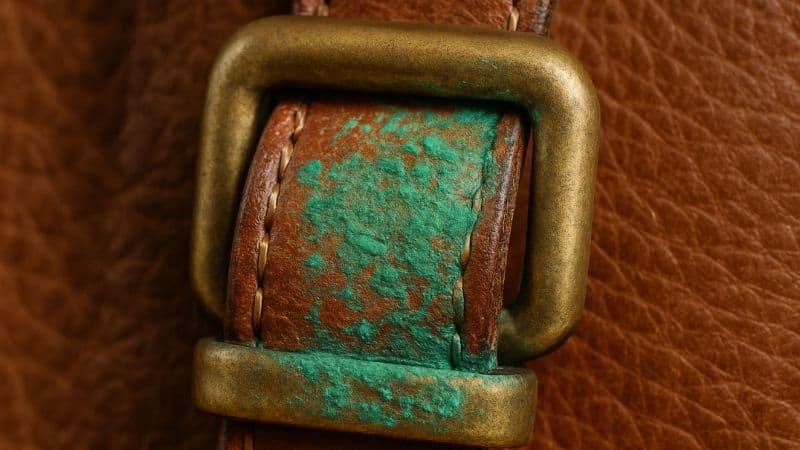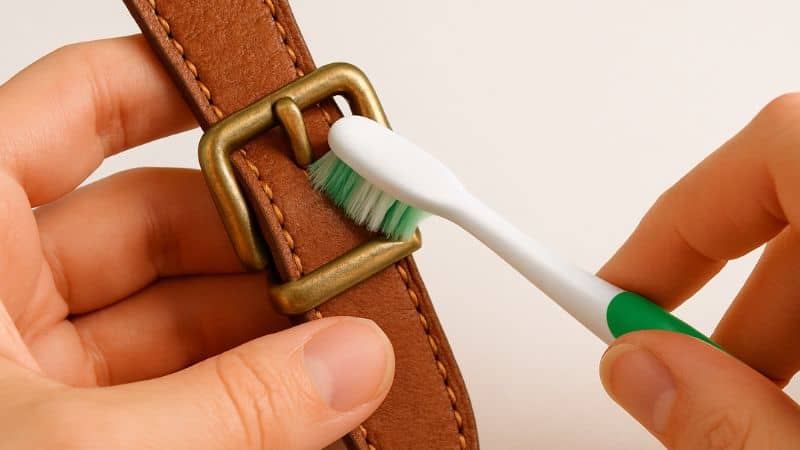Verdigris on leather can look alarming, especially when it shows up as that unmistakable greenish film around metal hardware. The good news is that it’s a common issue and one you can fix with patience and the right technique.
This guide walks you through how and why verdigris forms, what it means for your leather, and the safest way to remove it without causing leather damage. You don’t need special tools or advanced skills—just gentle handling and a bit of attention.
Once you understand what’s happening on the surface, restoring your leather becomes a much more approachable task.
What Is Verdigris on Leather?
Verdigris is the bluish-green corrosion that forms when copper or brass reacts with moisture, oils, or environmental conditions. When that corrosion rubs off onto leather, it leaves behind a residue that looks dramatic but is usually manageable.
- Verdigris develops naturally over time and is especially common on bags, belts, and accessories with brass or copper hardware. When the metal oxidizes, the byproduct can transfer to nearby leather, leaving a chalky or crusty patch.
- It’s important to recognize the difference between verdigris and mold. Verdigris has a distinctive blue-green color and forms near metal parts, while mold tends to look fuzzy and appears in random patches.
- Although verdigris itself originates from metal, it can slowly break down or discolor leather if it’s left untreated. That’s why early action is always your best move.
Now that you know exactly what you’re dealing with, it’s easier to approach the cleaning process with confidence.
Identify the Verdigris
Before you start cleaning, it helps to confirm that what you’re seeing really is verdigris and not dirt, dye transfer, or mildew. The clues are usually obvious once you know what to look for.
- Verdigris appears most frequently around buckles, rivets, metal corners, or decorative accents. If the discoloration is directly touching a copper or brass element, that’s a strong indicator.
- The texture of verdigris is either dusty, gritty, or slightly flaky. It doesn’t smear like dye transfer or soften like mold.
- Sometimes the leather may show faint greenish staining even if the hardware itself looks clean. This means the residue has transferred and begun reacting with the leather surface.
Confirming the issue helps you choose the right cleaning method, making the next step easier and more effective.
Prepare the Area
Cleaning verdigris is simple, but preparation makes the process cleaner and safer for both you and your leather item. A calm setup prevents unnecessary mistakes.
- Start by moving the item to a well-ventilated workspace with good lighting so you can see every affected spot clearly.
- Wear gloves, especially if the corrosion is powdery, to protect your skin and avoid transferring oils onto the leather.
- Lay a soft cloth or paper towel under the item—it keeps your surface clean and prevents loose particles from spreading everywhere.
- Keep your tools nearby: a soft brush, a damp cloth, cotton swabs, mild leather cleaner, and leather conditioner.
Once everything is in place, you’re ready to gently start removing the verdigris without causing unintended damage.
Dry-Brush the Verdigris Off
Dry brushing is the safest first step because it removes loose buildup without adding unnecessary moisture. The goal here is gentle, controlled cleaning.
- Use a soft toothbrush, suede brush, or any non-abrasive tool. Start brushing lightly in one direction to lift off the flaky corrosion.
- Avoid scrubbing aggressively, as pressure can push particles deeper into the leather fibers.
- Spend a bit more time around seams and tight corners, where residue tends to hide.
- Shake off the debris occasionally so you can clearly see your progress.
With most of the loose verdigris gone, the leather is now ready for a more precise cleaning step.
Clean the Leather Surface
Now that the majority of the residue is removed, it’s time to gently clean the affected area. This step helps break down the finer particles that brushing alone can’t remove.
- Dampen a microfiber cloth with mild leather cleaner or a small amount of water mixed with a drop of gentle soap.
- Wipe slowly using short, controlled motions—never saturate the leather, as too much moisture can cause its own problems.
- If the residue is stubborn, use a lightly moistened cotton swab to target small spaces near the hardware.
- Allow the leather to rest for a minute or two between light passes to prevent over-wetting.
With the surface now cleaner, you can move on to spot-treating any deeper areas of corrosion.
Treat Stubborn Verdigris (Optional)
Some patches of verdigris cling tightly to metal hardware and can create recurring buildup. Treating these spots makes future cleaning easier.
- Apply white vinegar to a cotton swab—just enough to dampen it, not soak it.
- Touch only the metal hardware with the swab. Keep vinegar away from the leather, as it can discolor or dry out the surface.
- Quickly wipe off the loosened residue with a clean cloth before it touches the leather.
- For heavily corroded hardware, you may need two or three light passes rather than one aggressive treatment.
Once the metal is clean, the leather will stay protected and future buildup becomes much less likely.
Dry the Area
Proper drying helps preserve the health of the leather and prevents water spots or warping. This step sets the foundation for conditioning.
- Dab the cleaned area with a dry microfiber cloth to absorb remaining moisture.
- Let the item air-dry naturally; avoid using heat sources like hair dryers, which can stiffen or shrink leather.
- Give the leather enough time—rushing the process can interfere with the conditioning step.
- Check the hardware after drying to ensure no new residue has appeared.
A fully dry surface ensures the conditioner can penetrate evenly and do its job well.
Dig Deeper: How to Condition Leather the Right Way
Condition the Leather
Conditioning restores softness and moisture, especially after cleaning, which may temporarily dry out the leather. This step keeps leather supple and prevents cracking.
- Apply a pea-sized amount of leather conditioner to a soft cloth and work it into the affected area using circular motions.
- Less is more—heavy application can attract dust or create buildup.
- Allow the conditioner to absorb for several minutes before buffing with a clean cloth.
- Condition the entire item if it hasn’t been treated in a while, not just the cleaned section.
Once the leather feels smooth and nourished again, you’re ready to focus on preventing future issues.
Prevent Future Verdigris
Keeping verdigris from returning is easier than dealing with it repeatedly. A few simple habits can dramatically reduce buildup.
- Regularly wipe down metal hardware with a dry cloth, especially after exposure to moisture or sweat.
- Polish copper or brass pieces occasionally to keep oxidation under control.
- Store leather goods in a cool, dry space, away from humidity.
- Use dust bags or breathable covers for long-term storage.
With these preventive habits, your leather stays cleaner longer—and your hardware stays brighter too.
FAQs
Can verdigris permanently damage leather?
Yes, it can if it’s ignored for long periods. Verdigris can stain leather fibers and become difficult to reverse. Early cleaning prevents most long-term issues. With consistent care, you can stop the damage before it starts.
Is verdigris toxic to touch?
Verdigris isn’t highly dangerous, but it’s best to avoid direct contact. Wearing gloves prevents skin irritation and keeps oils off your leather. Proper handling keeps both you and your item safe.
Can I use vinegar directly on leather to remove verdigris?
No—vinegar can discolor or dry out leather. It should be used only on metal hardware. If any vinegar touches leather accidentally, wipe it off immediately and condition the area later.
Why does my leather bag keep getting verdigris?
Repeated exposure to moisture, oils, or humidity speeds up oxidation on copper or brass. When hardware corrodes, the residue transfers to nearby leather. Regular cleaning and proper storage reduce recurrence.
What if the verdigris has stained the leather already?
Light stains can sometimes be reduced with repeated gentle cleaning and conditioning. Deep stains, however, may require professional leather restoration. Addressing the corrosion early helps prevent this outcome.
Can I use metal polish to remove verdigris?
Metal polish works well on hardware, but must be kept away from the leather. Apply it carefully with a small applicator. Always wipe away excess to prevent transfer.
Does sunlight help prevent verdigris?
Not really—sunlight can actually dry out or fade leather. Verdigris prevention relies more on dryness, airflow, and maintaining clean hardware. Store items in stable, moderate conditions.
Keep Your Leather Looking Its Best
Caring for leather doesn’t have to be complicated—just consistent. Verdigris may look ugly, but it’s easy to control once you understand what causes it and how to remove it safely.
With a little attention to cleaning, conditioning, and proper storage, your leather pieces can stay vibrant and durable for years. And now that you know how to tackle verdigris, you’re well equipped to keep them looking their best.




